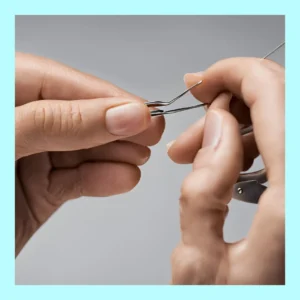Is It Time for a Fix? Signs You Need Hearing Aid Repair
Hearing aids are fantastic tools that greatly enhance your hearing and your cognitive health. However, sometimes issues arise that impact sound quality. Here are some common problems, what they might mean, and what hearing aid repairs might help:
Muffled Sounds: When Clarity Becomes a Challenge
Symptoms: Sounds seem dull, unclear, or distorted, like you’re listening through a pillow.
Possible Causes:
- Earwax Buildup: Earwax can block the receiver or microphone in your hearing aid, muffling the sound.
- Dead Battery: A low battery can weaken the signal and affect sound quality.
- Improper Fit: If your hearing aids don’t fit snugly, sound leakage can occur, reducing clarity.
- Faulty Microphone or Receiver: A malfunctioning microphone or receiver within the hearing aid can distort sound.

Silent Treatment: What to Do When Your Hearing Aid Goes Quiet
Symptoms: One or both hearing aids suddenly stop producing sound altogether.
Possible Causes:
- Dead Battery: The most common culprit. Replace the battery with a fresh one.
- Moisture Damage: If your hearing aids get wet, they might malfunction or stop working entirely.
- Technical Malfunction: Internal component failure within the hearing aid.
Volume Variations: When Loudness Levels are Unpredictable
Symptoms: Uncontrollable fluctuations in volume, with sounds becoming too loud or too soft unexpectedly.
Possible Causes:
- Faulty Volume Control: The volume control wheel or hearing aid button might malfunction.
- Feedback or Whistling: This can occur due to improper fit or a blockage in the hearing aid vent. Adjusting the fit or cleaning the vent might resolve the issue.
- Programming Issues: Your hearing aids might require reprogramming by your hearing healthcare professional to optimize volume control.
What to Do When You Experience These Issues
Don’t Panic: These problems are usually manageable.
Basic Troubleshooting:
- Check the battery and replace it if needed.
- Clean your hearing aids with a soft, dry cloth following the manufacturer’s instructions.
- Ensure your hearing aids are turned on, and the volume is adjusted appropriately.
Consult Your Hearing Healthcare Provider:
If basic troubleshooting doesn’t resolve the issue, schedule an appointment with your hearing healthcare professional.
They can diagnose the problem, perform any necessary repairs or adjustments, and ensure your hearing aids are functioning optimally.
Preventing Issues
- Regular Cleaning: Clean your hearing aids regularly to prevent earwax buildup.
- Moisture Management: Avoid exposing your hearing aids to excessive moisture.
- Handle with Care: Store your hearing aids in their protective case when not in use.
- Scheduled Appointments: Attend regular appointments with your hearing healthcare provider for maintenance, cleaning, and adjustments.
By understanding these common sound issues and taking proactive steps, you can ensure your hearing aids continue to provide you with a straightforward and enjoyable listening experience.
Noisy Nights: Tackling Feedback, Static, and Distorted Sounds
Hearing aids amplify sound to improve your listening experience. At night, when it’s quieter, unwanted noises like feedback, static, or distortion can disrupt your sleep. Here’s how to handle these issues:
Whistling Woes: Troubleshooting Feedback and Squealing Noises
Symptoms: A high-pitched whistling or squealing sound from your hearing aids, either constant or intermittent.
Cause: Feedback occurs when amplified sound leaks out of the ear canal and is picked up again by the microphone.
Solutions:
- Adjust the Fit: Ensure your hearing aids fit snugly to minimize sound leakage. This might involve using different earmolds or domes.
- Lower the Volume: Try reducing the volume on your hearing aids slightly if the feedback is mild.
- Change the Program: Some hearing aids have programs to reduce feedback. Consult your hearing healthcare professional.
- Check for Blockages: Clean your hearing aids regularly to prevent earwax buildup, which can cause feedback.
Static and Interference: Identifying Electronic Disturbances
Symptoms: Crackling, popping, or buzzing sounds in your hearing aids, often intermittent.
Causes: Electromagnetic interference (EMI) from electronic devices like TVs, radios, or cell phones can disrupt the signal in your hearing aids.
Solutions:
- Identify the Source: Turn off nearby electronic devices to see if the static disappears.
- Increase Distance: Move away from the source of the interference.
- Upgrade: Digital hearing aids are less susceptible to EMI than analog models. Discuss upgrading with your hearing healthcare professional.
Distorted Sounds: Dealing with Unnatural Audio Quality
Symptoms: Sounds seem distorted, metallic, or robotic, making them unpleasant to listen to.
Causes: Several factors can contribute to distorted sound, including:
- Dead Battery: A low battery can weaken the signal and affect sound quality.
- Improper Programming: Your hearing aids might need adjustments to optimize sound processing.
- Faulty Microphone or Receiver: Malfunctioning internal components can distort the sound.
Solutions:
- Replace the Battery: Start with a fresh battery to rule out low battery issues.
- Schedule an Appointment: Consult your hearing healthcare professional for a checkup. They can assess the cause of the distortion and reprogram your hearing aids if necessary. In some cases, you might need repairs.
Consistent Use
Regularly wearing your hearing aids helps train your brain to adjust to amplified sounds, minimizing the perception of these noises at night.
Addressing these common issues can ensure that your hearing aids provide a clear and enjoyable listening experience day and night.
Power Struggles: Battery Blues and Connectivity Conundrums
Hearing aids rely on batteries and often include wireless features for device connectivity. Here’s a breakdown of common issues related to battery life and connectivity:
Battery Blues: Frequent Power Issues and What They Mean
Symptoms: More frequent battery drain, requiring constant replacements.
Possible Causes:
- Hearing Aid Usage: Long durations of use or frequent audio/call streaming drain batteries faster.
- Battery Quality: Low-quality batteries drain faster than recommended ones.
- Hearing Aid Settings: High volume or Bluetooth streaming consumes more power.
- Hearing Loss Progression: Worsening hearing loss makes hearing aids work harder, draining the battery quicker.
Solutions:
- Monitor Usage: Track battery life and replace it proactively before they die completely.
- Invest in High-Quality Batteries: Choose reliable, long-lasting batteries from reputable brands.
- Adjust Settings: Discuss adjustments with your hearing healthcare provider to optimize battery life.
- Schedule a Hearing Test: If hearing loss is progressing, get an evaluation for necessary adjustments.
Connectivity Conundrums: Problems with Wireless Features
Symptoms: Difficulty connecting hearing aids to phone, TV, or other Bluetooth devices.
Possible Causes:
- Bluetooth Compatibility Issues: Incompatibility between hearing aids and the device.
- Connection Range Issues: Outside the effective Bluetooth range,
- Software or App Problems: Outdated software or app glitches on hearing aids or connected devices.
Solutions:
- Consult the Manuals: Refer to user manuals for pairing instructions.
- Check Compatibility: Ensure hearing aids and the device are compatible.
- Update Software: Install the latest updates for hearing aids and connected devices.
- Restart Devices: Restart hearing aids and connected devices to resolve minor glitches.
- Consult Your Hearing Healthcare Provider: Seek assistance if problems persist.
Find out more about hearing aids with Bluetooth.
Delayed Reactions: Slow Response Times from Your Device
Symptoms: Noticeable delay between sound occurrence and hearing it through hearing aids.
Possible Causes:
- Bluetooth Processing: Wireless connections are slightly delayed compared to direct audio input.
- Hearing Aid Processing: Digital signal processing might take time to analyze and amplify sounds.
Solutions:
- Be Aware of Limitations: Slight delays are inherent with Bluetooth and digital processing.
- Check for Updates: Ensure your hearing aids have the latest firmware updates for better processing speed.
- Consult Your Audiologist: Discuss excessive delays with your hearing healthcare professional.
Modern hearing aids are complex devices with occasional glitches or battery issues. Understanding these potential problems and following recommended solutions can ensure optimal performance and a more satisfying hearing experience.
Fit and Function: Physical Wear, Moisture, and Button Breakdowns
Your hearing aids are an investment in better hearing. Proper care ensures they work well for a long time. Here’s how to handle common physical issues:
Fit and Comfort: Recognizing Physical Wear and Tear
Symptoms: Discomfort, pain, loose fit, or frequent whistling and feedback.
Causes: Earmolds or domes can wear out, lose shape, or become clogged with earwax.
Solutions:
- Regular Inspections: Check your earmolds or domes regularly for signs of wear.
- Cleaning and Maintenance: Clean your hearing aids and earmolds/domes to remove earwax buildup.
- Replacements: Schedule regular appointments for professional cleanings and replacements if needed.
Explore more about hearing aid domes.
Moisture Mishaps: The Impact of Water Damage on Your Hearing Aid
Symptoms: Hearing aids stop working or produce static and crackling sounds after moisture exposure.
Causes: Sweat, rain, or condensation can damage internal components.
Solutions:
- Be Mindful of Moisture: Avoid exposing your hearing aids to excessive moisture.
- Drying Kits: Use a hearing aid drying kit after accidental exposure.
- Professional Help: Consult your hearing healthcare provider for assessment and potential repairs. Some hearing aids are water-resistant; check with your provider.

Button Breakdowns: Malfunctions in Controls and Switches
Symptoms: Buttons or volume controls become unresponsive, stuck, or challenging to operate.
Causes: Regular use can wear out the buttons and switches.
Solutions:
- Gentle Use: Handle your hearing aids carefully and avoid pressing buttons too hard.
- Cleaning: Clean the buttons and switches with a dry cloth following the manufacturer’s instructions.
- Professional Repair: If buttons or switches malfunction, consult your hearing healthcare provider for repairs or replacements.
Preventive care maximizes the lifespan and functionality of your hearing aids. Follow these tips and attend regular appointments with your hearing healthcare professional for a comfortable and optimal hearing experience.
Wax Woes and Visual Clues: Inspecting for Buildup and Damage
Hearing aids are precision instruments. Even small amounts of earwax or physical damage can affect their performance. Here’s how to identify and address these issues:
Wax Woes: How Earwax Buildup Affects Your Hearing Aid
Symptoms: Reduced sound quality, muffled sounds, increased volume needs, or feedback/whistling noises.
How Earwax Affects Hearing Aids: Earwax can clog the receiver or microphone, hindering their function.
Prevention and Cleaning:
- Regular Cleaning: Clean your hearing aids daily with a soft, dry cloth.
- Use a Cleaning Brush: Gently brush away visible earwax from the receiver, microphone openings, and vents.
- Scheduled Cleanings: Schedule regular professional cleanings to remove stubborn wax buildup.
Visual Clues: Inspecting for Physical Damage
Symptoms: Visible cracks, loose battery compartments, or corroded battery contacts.
What to Do:
- Self-Inspection: Regularly inspect your hearing aids for any visible signs of damage.
- Seek Professional Help: If you notice any damage, consult your hearing healthcare professional for proper assessment and repairs.
Inconsistent Performance: When Your Hearing Aid Works Sporadically
Symptoms: Hearing aid works intermittently, or sound quality fluctuates unexpectedly.
Possible Causes:
- Low Battery: A weak battery can cause inconsistent performance.
- Loose Battery Connection: An insecure battery compartment can cause the hearing aid to cut in and out.
- Internal Component Issues: Malfunctioning internal components might be responsible.
Troubleshooting:
- Check the Battery: Replace the battery with a fresh one.
- Clean the Battery Compartment: Ensure it is clean and free of debris.
- Consult Your Hearing Healthcare Professional: Schedule an appointment for a thorough diagnosis and potential repairs.
Regularly inspecting your hearing aids for wax buildup or damage and being attentive to performance inconsistencies can help address issues promptly. This ensures optimal functionality and a continued positive experience with your hearing aids.
Tune-Up Time: Knowing When It’s Time for a Professional Fix
Maintaining your hearing aids ensures they provide the best possible experience. By addressing issues like muffled sounds, battery problems, feedback, and physical damage, you can enjoy clearer hearing every day. Regular inspections and cleanings, along with professional help when needed, keep your hearing aids in top shape.
Don’t hesitate to reach out if you’re experiencing any of these issues. We’re here to help you with all your hearing aid repair needs. Contact Stanford Hearing today for expert care and support. Your hearing is our priority!
